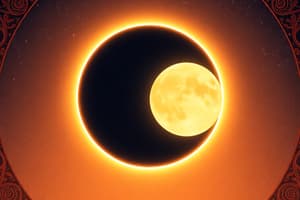Podcast
Questions and Answers
¿Qué tipo de eclipse solar se observa fuera del área cubierta por la sombra interna de la Luna?
¿Qué tipo de eclipse solar se observa fuera del área cubierta por la sombra interna de la Luna?
- Eclipse solar parcial (correct)
- Eclipse solar total
- Eclipse solar anular
- No se observa ningún eclipse solar
¿Cuál es la razón principal por la que ocurren los eclipses solares?
¿Cuál es la razón principal por la que ocurren los eclipses solares?
- La inclinación de la órbita de la Tierra alrededor del Sol
- La variación en la distancia entre la Tierra y el Sol
- La alineación de la Tierra, la Luna y el Sol
- La inclinación de la órbita de la Luna alrededor de la Tierra (correct)
¿Cuál es uno de los efectos psicológicos de los eclipses solares en la Tierra?
¿Cuál es uno de los efectos psicológicos de los eclipses solares en la Tierra?
- Provocan interrupciones en las actividades diarias
- Causan sentimientos de miedo y pánico
- Inspiran curiosidad y asombro sobre los eventos celestiales (correct)
- Conducen a una mayor comprensión de los fenómenos astronómicos
¿Cuál es uno de los efectos astronómicos de los eclipses solares en la Tierra?
¿Cuál es uno de los efectos astronómicos de los eclipses solares en la Tierra?
¿Qué ocurre cuando la sombra de la Tierra cubre a la Luna en su posición relativa?
¿Qué ocurre cuando la sombra de la Tierra cubre a la Luna en su posición relativa?
¿Qué tipo de eclipse solar ocurre cuando la Luna se encuentra en su punto más lejano de la Tierra?
¿Qué tipo de eclipse solar ocurre cuando la Luna se encuentra en su punto más lejano de la Tierra?
Durante un eclipse solar total, ¿qué parte del Sol se puede observar?
Durante un eclipse solar total, ¿qué parte del Sol se puede observar?
¿Cuál de los siguientes efectos se produce en la Tierra durante un eclipse solar total?
¿Cuál de los siguientes efectos se produce en la Tierra durante un eclipse solar total?
¿Qué causa los diferentes tipos de eclipses solares?
¿Qué causa los diferentes tipos de eclipses solares?
Durante un eclipse solar parcial, ¿cómo se ve el Sol?
Durante un eclipse solar parcial, ¿cómo se ve el Sol?
Flashcards are hidden until you start studying
Study Notes
Solar Eclipses
Since antiquity, humans have been fascinated by the cosmic dance of celestial bodies involved in a solar eclipse. These events occur when the Moon passes between Earth and the Sun, effectively casting a shadow on Earth's surface. Solar eclipses can be classified into three main types: partial, annular, and total.
Types of Solar Eclipses
Total Solar Eclipse
A total solar eclipse is a rare and spectacular phenomenon where the Moon completely covers the Sun, revealing the Sun's outer atmosphere (the corona). People located in the center of the Moon's shadow when it hits Earth will experience this type of eclipse. The sky darkens as if it were dawn or dusk, and under clear skies, viewers can witness the corona.
Annular Solar Eclipse
An annular solar eclipse happens when the Moon passes between the Sun and Earth but is at or near its farthest point from Earth. In this case, the Moon appears smaller than the Sun and does not completely cover it. As a result, the Moon appears as a dark disk on top of a larger, bright disk, creating what looks like a ring around the Moon. This gives the appearance that the Moon has 'lost' some of its mass, hence the name "annular" derived from Latin for "ring-shaped".
Partial Solar Eclipse
A partial solar eclipse occurs when the Moon passes between the Sun and Earth but they are not perfectly aligned. Only part of the Sun will appear to be covered, giving it a crescent shape. During a total or annular solar eclipse, people outside the area covered by the Moon's inner shadow see a partial solar eclipse.
Causes of Solar Eclipses
Solar eclipses occur because the Moon's orbit around Earth is tilted with respect to Earth's orbit around the Sun. This means that Earth's shadow falls upon the invariable parts of the Moon's orbit, causing a periodic eclipse. When the Earth's shadow covers the moon while in its relative position, we observe a lunar eclipse.
Effects of Solar Eclipses on Earth
The effects of solar eclipses on Earth are both astronomical and psychological. From an astronomical perspective, solar eclipses provide unique insights into phenomena such as sunspots, the solar wind, and the solar corona, which are otherwise difficult to study. They also offer opportunities for scientists to calibrate instruments designed to measure the amount of sunlight reaching Earth.
Psychologically, solar eclipses have been associated with feelings of awe and wonder, often leading to collective experiences that transcend cultural boundaries. They serve as reminders of our place in the universe and inspire curiosity about celestial events.
Studying That Suits You
Use AI to generate personalized quizzes and flashcards to suit your learning preferences.




